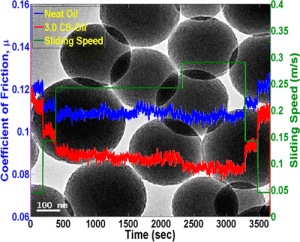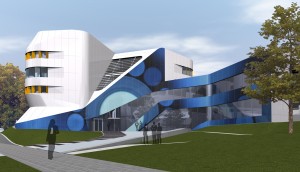I have two car-oriented news items today. The first concerns the introduction of carbon nanospheres into lubricants as a means of reducing friction. From a March 5, 2015 news item on Nanowerk,
Tiny, perfectly smooth carbon spheres added to motor oil have been shown to reduce friction and wear typically seen in engines by as much as 25 percent, suggesting a similar enhancement in fuel economy.
The researchers also have shown how to potentially mass-produce the spheres, making them hundreds of times faster than previously possible using ultrasound to speed chemical reactions in manufacturing.
“People have been making these spheres for about the last 10 years, but what we discovered was that instead of taking the 24 hours of synthesis normally needed, we can make them in 5 minutes,” said Vilas Pol, an associate professor of chemical engineering at Purdue University.
The spheres are 100-500 nanometers in diameter, a range that generally matches the “surface roughness” of moving engine components.
“So the spheres are able to help fill in these areas and reduce friction,” said mechanical engineering doctoral student Abdullah A. Alazemi.
A March 4, 2015 Purdue University news release by Emil Venere, which originated the news item, elaborates on the impact this finding could have (Note: A link has been removed),
Tests show friction is reduced by 10 percent to 25 percent when using motor oil containing 3 percent of the spheres by weight.
…
“Reducing friction by 10 to 25 percent would be a significant improvement,” Sadeghi said. “Many industries are trying to reduce friction through modification of lubricants. The primary benefit to reducing friction is improved fuel economy.”
Friction is greatest when an engine is starting and shutting off, so improved lubrication is especially needed at those times.
“Introducing microspheres helps separate the surfaces because the spheres are free to move,” Alazemi said. “It also is possible that these spheres are rolling and acting as little ball bearings, but further research is needed to confirm this.” [emphasis mine]
Findings indicate adding the spheres did not change the viscosity of the oil.
“It’s very important not to increase the viscosity because you want to maintain the fluidity of the oil so that it can penetrate within engine parts,” Alazemi said.
The spheres are created using ultrasound to produce bubbles in a fluid containing a chemical compound called resorcinol and formaldehyde. The bubbles expand and collapse, generating heat that drives chemical reactions to produce polymer particles. These polymeric particles are then heated in a furnace to about 900 degrees Celsius, yielding the perfectly smooth spheres.
“A major innovation is that professor Pol has shown how to make lots of these spheres, which is important for potential industrial applications,” Sadeghi said.
Etacheri said, “Electron microscopy images and Raman spectra taken before and after their use show the spheres are undamaged, suggesting they can withstand the punishing environment inside engines and other machinery.”
Funding was provided by Purdue’s School of Chemical Engineering. Electron microscopy studies were performed at the Birck Nanotechnology Center in Purdue’s Discovery Park.
Future research will include work to determine whether the spheres are rolling like tiny ball bearings or merely sliding. A rolling mechanism best reduces friction and would portend well for potential applications. Future research also will determine whether the resorcinol-formaldehyde particles might themselves be used as a lubricant additive without heating them to produce pure carbon spheres.
I’m not sure why the researcher is referring to microspheres as the measurements are at the nanoscale, which should mean these are ‘nanospheres’ or, as the researchers have it in the title for their paper, ‘submicrometer spheres’.
Here’s a link to and a citation for the paper,
Ultrasmooth Submicrometer Carbon Spheres as Lubricant Additives for Friction and Wear Reduction by Abdullah A. Alazemi, Vinodkumar Etacheri, Arthur D. Dysart, Lars-Erik Stacke, Vilas G. Pol, and Farshid Sadeghi. ACS Appl. Mater. Interfaces, Article ASAP DOI: 10.1021/acsami.5b00099 Publication Date (Web): February 17, 2015
Copyright © 2015 American Chemical Society
This paper is behind a paywall but there is an instructive image freely available,

This image taken with an electron microscope shows that tiny carbon spheres added to motor oil reduce friction and wear typically seen in engines by as much as 25 percent, suggesting a similar enhancement in fuel economy. Purdue researchers also have shown how to potentially mass-produce the spheres. (Purdue University image)
My second car item concerns thin films and touch. From a March 5, 2015 news item on Azonano (Note: A link has been removed),,
Canatu, a leading manufacturer of transparent conductive films, has in partnership with Schuster Group [based in Germany] and Display Solution AG [based in Germany], showcased a pioneering 3D encapsulated touch sensor for the automotive industry.
The partnership is delivering the first ever, button free, 3D shaped true multitouch panel for automotives, being the first to bring much anticipated touch applications to dashboards and paneling. The demonstrator provides an example of multi-functional display with 5 finger touch realized in IML [in mould labeling] technology.
A March 5, 2015 Canatu press release, which originated the news item, provides more details about the technology and some insight into future plans,
The demonstrator provides an example of multi-functional display with 5 finger touch realized in IML technology. The integration of touch applications to dashboards and other paneling in cars has long been a desired by automotive designers but a suitable technology was not available. Finally the technology is now here. Canatu’s CNB™ (Carbon NanoBud®) In-Mold Film, with its unique stretch properties provides a clear path to the eventual replacement of mechanical controls with 3D touch sensors. The touch application was made using an existing mass manufacturing tool and industry standard processes.
Specifically designed for automobile center consoles and dashboards, household machines, wearable devices, industrial user interfaces, commercial applications and consumer devices, CNB™ In-Mold Films can be easily formed into shape. The film is first patterned to the required touch functionality, then formed, then back-molded by injection molding, resulting in a unique 3D shape with multitouch functionality.
With a bending radius of 1mm, CNB™ In-Mold Films can bring touch to almost any surface imaginable. The unique properties of CNB™ In-Mold Films are unmatched as no other film on the market can be stretched 120% and molded without losing their conductivity.
You can find out more about Canatu, based in Finland, here.
